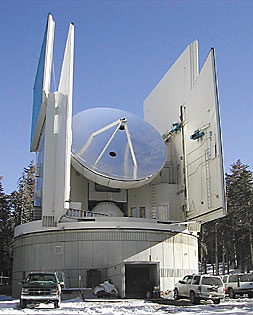 |
|
PHOTO COURTESY Of KITT PEAK OBSERVATORY
|
Kitt Peak is one of the sites UA uses to study astronomy. Its radio telescopes, pictured here, can be used to attempt to discover life on other planets. UA was recently awarded a grant to participate in such studies.
|
|
|
By Ashley Nowe
Arizona Daily Wildcat
Thursday, September 18, 2003
The UA's search for life on other planets has gotten a $5 million boost.
In August, about 15 UA scientists joined the NASA Astrobiology Institute and the National Optical Astronomy Observatory to search for life inside and outside the solar system.
The UA will receive a $1 million-per- year budget from the NAI that lasts for five years before the UA must reapply.
"It is really hard to get into this program," said Nick Woolf, professor of astronomy, who leads the Tucson-based project. "Even schools like Harvard got denied this time around."
"In order to learn more about how our planet started, we need to look into other solar systems and see what is happening there," Woolf said.
UA scientists, from the astronomy department to the geosciences department, will be looking into the origin, evolution and the future of life on Earth.
"This is really our hunting license," Woolf said.
The $1 million dollar a year budget that the NAI provides will help the teams look into three research areas in planetary development ÷ the gases that form planets, young planets that are evolving and planets that are already matured.
In order to better understand Earth's formation, researchers will look at the compounds and molecules that exist in space to see how often planet formation occurs.
Steve Strom, associate director of the NOAO, said, "We also need to see how the changes in a young sun's energy output might influence the evolution of life on Earth-like planets in other solar systems."
Another group of researchers will study the evolution of young parent stars, a star that other planets rotate around such as the sun.
"We will look at stars, similar to the sun, that are only 1/2 billion years old, which was before life began on Earth, and see what is happening during this time period," Woolf said. "This might tell us what was happening on Earth around this time."
The other goal of the project is to take a direct image of a planet, which has never been done, said Phil Hinz, assistant professor of astronomy.
"It would be very interesting to be the first to take a direct image of a planet," Hinz said. "The amount of information you can get from this would be amazing, because until we take an actual image there is only so much we can learn."
Researchers will be using Mount Graham's 11.8-meter Large Binocular Telescope and the 10-meter Submillimeter Telescope, as well as Kitt Peak's 12-meter Telescope. The National Optical Astronomy Observatory operates the Kitt Peak telescope.
The binocular telescope, which uses the largest single piece of glass in the world, is still being built and is expected to be complete in late 2005.
Researchers are looking for signs of water and oxygen, which show suitability for life.
"This research sets the stage for a NASA mission to look and see if life really does exist on other planets," Hinz said.
